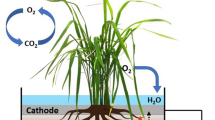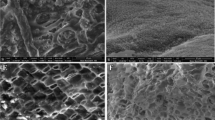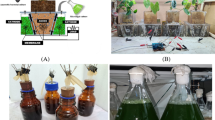Abstract
The plant microbial fuel cell (PMFC) is the emerging technology that uses the photosynthetic reaction of plants to generate renewable and sustainable bio-electricity. In the present work, Epipremnum aureum plant was used to produce clean and sustainable bio-energy in a PMFC. The synergistic effect of the composite anode made up of carbonized corncob and the carbon rod on the electricity generation and plant growth was observed. The maximum power output of the PMFC with the composite carbonized corncob-carbon rod anode was 73.73 mW/m2 which is much higher than the power output of PMFC with the plain carbon rod anode of 0.71 mW/m2. High growth of the plant may be attributed to increase in the plant microbial interaction in the rhizosphere region which facilitates the transport of nutrients and exchange of electrons between the plant and the electrode. Therefore, the composite carbonized corncob anode could be coupled with the higher generation of bioelectricity within 35 working days.
Graphical abstract







Similar content being viewed by others
References
Strik DP, Timmers RA, Helder M, Steinbusch KJ, Hamelers HV, Buisman CJ (2011) Microbial solar cells: applying photosynthetic and electrochemically active organisms. Trends Biotechnol 29(1):41–49
Bose D, Dhawan H, Kandpal V, Vijay P, Gopinath M (2018) Bioelectricity generation from sewage and wastewater treatment using two-chambered microbial fuel cell. Int J Energy Res 42:4335–4344
Bose D, Gopinath M, Vijay P (2016) Sustainable power generation from wastewater sources using microbial fuel cell. Biofuels Bioprod Bioref 12:559–576
Chimurkar A, Chandorkar V, Gomashe A (2018) Voltage production using metabolic activities of Azatobacter species and other soil microbial flora in rice field using microbial fuel cell and microbial solar cell technology. Agric Sci Dig A Res J 38(4):310–312
Maddalwar S, Nayak KK, Kumar M, Singh L (2021) Plant microbial fuel cell: opportunities, challenges, and prospects. Biores Technol 341:125772
Sonu K, Syed Z, Sogani M (2019) Microbial fuel cell in domestic wastewater treatment plant—an innovative step towards energy generation and waste reduction. J Sci Ind Res 78:555–557
Sarma PJ, Mohanty K (2018) Epipremnum aureum and Dracaena braunii as indoor plants for enhanced bio-electricity generation in a plant microbial fuel cell with electrochemically modified carbon fiber brush anode. Biosci Bioeng 126(3):404–410
Thakur S, Das B (2021) Performance evaluation of microbial fuel cell with sewage wastewater and RO concentrate using composite anode made of Luffa aegyptiaca. Environ Prog Sustain 40(1):e13504
Sonu K, Sogani M, Syed Z, Dongre A, Sharma G (2020) Effect of corncob derived biochar on microbial electroremediation of dye wastewater and bioenergy generation. ChemistrySelect 5(31):9793–9798
Maddalwar SR, Shanware AS (2018) Growth curve analysis of Rhizobium leguminosarum using voltage produced by microbial fuel cell. Int J Life Sci Scienti Res eISSN, 2455(1716):1716
Helder M, Strik DP, Timmers RA, Raes SM, Hamelers HV, Buisman CJ (2013) Resilience of roof-top plant-microbial fuel cells during Dutch winter. Biomass Bioenergy 51:1–7
Sonu K, Sogani M, Syed Z, Dongre A, Sharma G (2021) Improved decolorization of dye wastewater and enhanced power output in the electrically stacked microbial fuel cells with H2O2 modified corncob anodes. Environ Prog Sustain 9:ep13638
Sonu K, Das B (2016) Comparison of the output voltage characteristics pattern for sewage sludge, kitchen waste and cow dung in single chamber single electrode microbial fuel cell. Indian J Sci Technol 9(30):1–5
Bajpai M, Katoch SS, Chaturvedi NK (2019) Comparative study on decentralized treatment technologies for sewage and graywater reuse—a review. Water Sci Technol 80:2091–2106
Timmers RA, Strik DP, Hamelers HV, Buisman CJ (2010) Long-term performance of a plant microbial fuel cell with Spartina anglica. Appl Microbiol Biotechnol 86(3):973–981
Wetser K, Dieleman K, Buisman C, Strik D (2017) Electricity from wetlands: tubular plant microbial fuels with silicone gas-diffusion biocathodes. Appl Energy 185:642–649
Helder M, Strik DP, Hamelers HV, Buisman CJ (2012) The flat-plate plant-microbial fuel cell: the effect of a new design on internal resistances. Biotechnol Biofuels 5(1):1–1
Goto Y, Yoshida N, Umeyama Y, Yamada T, Tero R, Hiraishi A (2015) Enhancement of electricity production by graphene oxide in soil microbial fuel cells and plant microbial fuel cells. Front Bioeng Biotechnol 1:33–42
Das S, Das S, Das I, Ghangrekar MM (2019) Application of bioelectrochemical systems for carbon dioxide sequestration and concomitant valuable recovery: a review. Mater Sci Energy Technol 2(3):687–696
Manolopoulou E, Varzakas T, Petsalaki A (2016) Chlorophyll determination in green pepper using two different extraction methods. Curr Res Nutr Food Sci 25:52–60
Chakraborty I, Das S, Dubey BK, Ghangrekar MM (2020) Novel low cost proton exchange membrane made from sulphonated biochar for application in microbial fuel cells. Mater Chem Phys 239:122025
Das I, Das S, Ghangrekar MM (2020) Application of bimetallic low-cost CuZn as oxygen reduction cathode catalyst in lab-scale and field-scale microbial fuel cell. Chem Phys Lett 751:137536
Das S, Chakraborty I, Rajesh PP, Ghangrekar MM (2020) Performance evaluation of microbial fuel cell operated with Pd or MnO2 as cathode catalyst and Chaetoceros pretreated anodic inoculum. J Hazard Toxic Radioact Waste 24(3):04020009
Das S, Mishra A, Ghangrekar MM (2020) Production of hydrogen peroxide using various metal-based catalysts in electrochemical and bioelectrochemical systems: mini review. J Hazard Toxic Radioact Waste 24(3):06020001
Yaqoob AA, Ibrahim MNM, Guerrero-Barajas C (2021) Modern trend of anodes in microbial fuel cells (MFCs): an overview. Environ Technol Innov 23:101579
Yaqoob AA, Ibrahim MNM, Rodríguez-Couto S (2020) Development and modification of materials to build cost-effective anodes for microbial fuel cells (MFCs): An overview. Biochem Eng J 164:107779
Sonu K, Sogani M, Syed Z, Dongre A, Sharma G (2020) Enhanced decolorization and treatment of textile dye wastewater through adsorption on acid modified corncob derived biochar. ChemistrySelect 22(39):12287–12297
Tapia NF, Rojas C, Bonilla CA, Vargas IT (2018) A new method for sensing soil water content in green roofs using plant microbial fuel cells. Sensors 18(1):71. https://doi.org/10.3390/s18010071
Chen Z (2012) Energy from plants and microorganisms: progress in plant–microbial fuel cells. Chemsuschem 5:1006–1011
Moqsud MA, Yoshitake J, Bushra QS, Hyodo M, Omine K, Strik D (2015) Compost in plant microbial fuel cell for bioelectricity generation. Waste Manage 36:63–69
Liu S, Song H, Li X, Yang F (2013) Power generation enhancement by utilizing plant photosynthate in microbial fuel cell coupled constructed wetland system. Int J Photoenergy 2013:172010. https://doi.org/10.1155/2013/172010
Hubenova Y, Mitov M (2012) Conversion of solar energy into electricity by using duckweed in direct photosynthetic plant fuel cell. Bioelectrochemistry 87:185–191
Author information
Authors and Affiliations
Contributions
KS: visualization, methodology, data curation, formal analysis, writing—original draft preparation. MS: conceptualization, investigation, writing—original draft preparation, writing—reviewing and editing, supervision, project administration. ZS: data curation, formal analysis, writing—original draft preparation. JR: data curation, formal analysis, writing—original draft preparation. SCP: visualization, methodology, data curation, formal analysis.
Corresponding author
Ethics declarations
Conflict of interest
The authors declare no competing interests.
Additional information
Publisher's note
Springer Nature remains neutral with regard to jurisdictional claims in published maps and institutional affiliations.
Highlights
• Sustainable design of plant microbial fuel cell (PMFC) using Epipremnum aureum plant.
• Low-cost composite anode of carbonized corncob and carbon rod integrated in a PMFC.
• Power density of 73.73 mW/m2 achieved which is among the best in recent PMFC studies.
Rights and permissions
About this article
Cite this article
Sonu, K., Sogani, M., Syed, Z. et al. Performance evaluation of Epipremnum aureum plant-based microbial fuel cell using composite anode made up of carbonized corncob and carbon rod. Biomass Conv. Bioref. 14, 5149–5156 (2024). https://doi.org/10.1007/s13399-022-02794-6
Received:
Revised:
Accepted:
Published:
Issue Date:
DOI: https://doi.org/10.1007/s13399-022-02794-6




